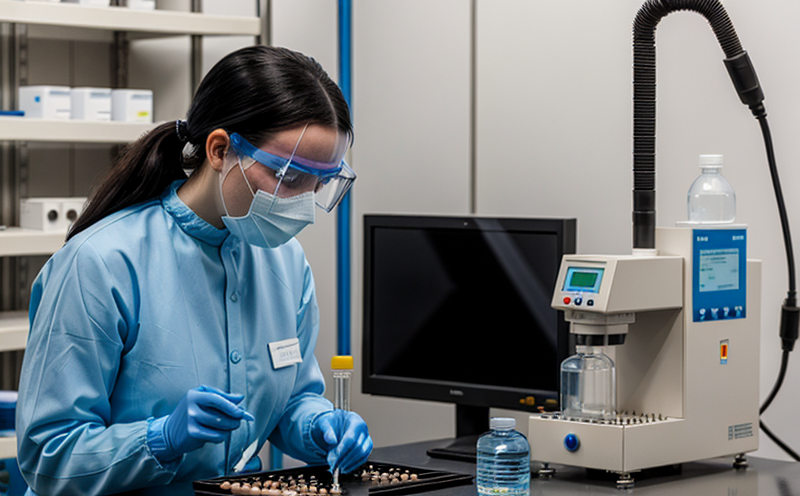AAS Heavy Metal Impurity Testing
In the pharmaceutical industry, ensuring drug quality and purity is paramount. The presence of heavy metals in medicinal products can lead to serious health risks. To address this critical concern, we offer AAS (Atomic Absorption Spectroscopy) Heavy Metal Impurity Testing. This service ensures that drugs meet stringent regulatory standards for safety and efficacy.
Our testing process employs state-of-the-art Atomic Absorption Spectrophotometers (AAS). These instruments are capable of detecting even trace amounts of heavy metals, such as mercury, lead, cadmium, arsenic, chromium, and others. The primary goal is to identify potential impurities that could compromise drug quality.
The testing process begins with sample preparation. This involves the dissolution of solid samples in appropriate solvents followed by filtration or centrifugation to remove insoluble materials. For liquid samples, dilution may be necessary to bring them within the linear range of the instrument. The prepared solutions are then introduced into the AAS for analysis.
The AAS technique works by atomizing the sample and passing a source of light through it. This causes atoms in the vaporized sample to absorb specific wavelengths of that light, which is then measured by a detector. The concentration of each metal can be determined based on the intensity of this absorption. Our team uses internationally recognized standards such as ISO 3651-2 and ASTM E1890-07 for our testing protocols.
The accuracy and precision of AAS Heavy Metal Impurity Testing are crucial in pharmaceutical manufacturing. Compliance with regulatory bodies like the FDA, EU, and WHO is essential to ensure that drugs meet safety standards. Our service provides reliable data on impurity levels which can inform quality control processes and help maintain product integrity.
Our expertise extends beyond mere detection; we also offer detailed reports highlighting any deviations from acceptable limits set by regulatory authorities. This information is invaluable for ongoing research, development, and manufacturing process optimization. By leveraging this service, stakeholders can make informed decisions about product safety and quality assurance.
Why It Matters
The importance of heavy metal impurity testing cannot be overstated in the pharmaceutical sector. Heavy metals like mercury, lead, and arsenic are toxic to humans even at low concentrations. Their presence in medicinal products can lead to serious health issues including neurological damage, kidney failure, cardiovascular diseases, among others.
Regulatory bodies around the world have established strict limits for heavy metal impurities in pharmaceuticals. For instance, the US Food and Drug Administration (FDA) specifies maximum allowable levels of certain metals based on their potential toxicity. Failure to adhere to these regulations can result in product recalls, legal action, and damage to brand reputation.
Our testing service plays a vital role in ensuring compliance with these stringent standards. By identifying even trace amounts of heavy metals early in the production process, we enable manufacturers to take corrective actions promptly. This proactive approach not only enhances patient safety but also protects companies from potential fines and lawsuits.
In addition to regulatory compliance, our testing service contributes significantly to maintaining high-quality pharmaceuticals. It helps ensure that products are free from contaminants that could affect their efficacy or stability over time. The use of reliable analytical techniques like AAS ensures consistent results across different batches and manufacturing sites.
Scope and Methodology
The scope of our Heavy Metal Impurity Testing service covers a wide range of pharmaceutical products, including tablets, capsules, injections, creams, and ointments. We also conduct tests on excipients, APIs (Active Pharmaceutical Ingredients), and packaging materials.
- Sample Preparation: Dissolution in appropriate solvents followed by filtration or centrifugation to remove insoluble materials.
- Instrumentation: State-of-the-art Atomic Absorption Spectrophotometers (AAS) capable of detecting trace amounts of heavy metals.
- Data Analysis: Utilizing internationally recognized standards such as ISO 3651-2 and ASTM E1890-07 for accurate quantification.
The methodology involves precise sample preparation, introduction into the AAS instrument, analysis, and interpretation. Our team of experts ensures that each step adheres to strict quality control measures. This comprehensive approach guarantees reliable results every time.
Our service is designed to meet the specific needs of various stakeholders within the pharmaceutical industry—quality managers, compliance officers, R&D engineers, and procurement personnel. By providing accurate data on impurity levels, we empower these individuals to make informed decisions that contribute to overall product quality and patient safety.
Environmental and Sustainability Contributions
The use of AAS Heavy Metal Impurity Testing contributes positively towards environmental sustainability by minimizing the release of hazardous materials into the environment. By identifying heavy metal impurities early in the manufacturing process, we help prevent their introduction into final products.
- Reduces risk of environmental contamination from improperly discarded pharmaceutical waste containing heavy metals.
- Promotes responsible disposal practices for pharmaceuticals that contain trace amounts of heavy metals.
- Supports sustainable production practices by ensuring compliance with international standards and regulations.
In addition, our testing service supports broader sustainability efforts by fostering a culture of quality and responsibility within the pharmaceutical industry. This contributes to long-term environmental health and well-being.





